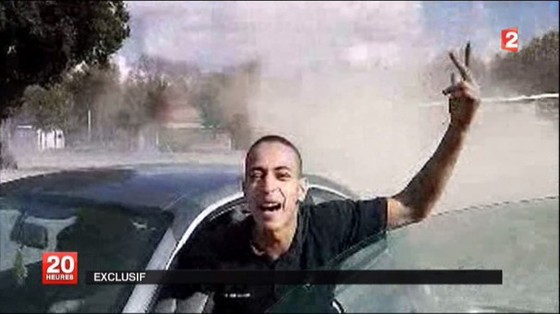Two years ago, when most media reports were generally parroting French officials’ claims that the deadly attack in March 2012 by Toulouse shooter Mohamed Merah was a “lone wolf”-type operation by a disadvantaged youth, we at The Long War Journal began exploring Merah’s likely al Qaeda connections. Merah had, after all, proclaimed that he was al Qaeda.
[See LWJ reports, Al Qaeda gunman in France reportedly escaped Afghan prison; French suspect claims al Qaeda ties, escaped from Kandahar jail; and Toulouse shooter’s al Qaeda ties played down by officials; and Threat Matrix reports, Jund al Khilafah claims French shooting; Al Qaeda touts operations in Ghazni; and Jund al Khilafah emir killed in ‘treacherous raid’.]
As we noted back in 2012, Merah had been trained in Pakistan by a Swiss jihadist named Moezeddine Garsallaoui, who was the leader of the al Qaeda-linked Jund al Khilafah until he was killed, most likely by a drone strike, in the jihadist haven of Miramshah in Pakistan’s North Waziristan in October 2012.
Now the media seems to be catching up, as the Jerusalem Post recently reported, citing a lengthy investigation by Le Parisen:
After 24 months of inquiry, [Le Parisien] recently obtained the first evidence of Mohammed Merah’s links with one of Osama bin Laden’s lieutenants, the paper said, quoting judicial sources.
Last December, Urynbasar Munatov, a 26-year-old Kazakh arrested in Pakistan in the fall of 2012, found guilty of terrorism and sentenced to 20 years in prison, revealed during questioning that he had discussed the apprentice terrorist (Merah) with Moez Garsallaoui, a Belgian-Tunisian who was responsible for al-Qaida in Europe. Garsallaoui had talked of the presence of the French Algerian in his training camp in Pakistan, a camp called Miran Shah located in the province of Waziristan. The camp was dedicated to the training of European jihad candidates. Urnybasar himself had been there.
…
Munatov revealed: “I saw [a photo of Merah], Garsallaoui himself showed it to me. He told me that his name was Muhammed Mira, that he had a second first name, Yussuf. He used to live in Waziristan, and also stayed for a while with Moez in Miran Shah.”
…
According to Moez “there was a deal between him and Yussuf: If he, Merah, took action, then Moez would consider them as his own, as having been organized and executed according to his orders.”
The Jerusalem Post article observed in conclusion that “[u]ntil now, Merah’s contacts with Garsallaoui were only presumed, since it was hard to believe that a young man without a good level of Arabic could be involved with one of bin Laden’s assistants, and also because there was no traces of relevant messages in his emails.”
But again, as we noted back on March 22, 2012, the day Merah’s shooting spree ended when he was killed in a standoff with French police, Jund al Khilafah issued a statement claiming responsibility for his “blessed operations” that had begun on March 19.
In light of the above, maybe it’s time to reassess the almost reflexive tendency of authorities to claim, whenever there is a terrorist act apparently committed by one individual or just a few, that the attack was probably perpetrated by a “lone wolf.” Although a weak argument can be made that such dismissals give authorities time to investigate while playing dumb, they also mislead a public that lacks the attention span to follow a news story until the key facts are revealed.
Al Qaeda and its numerous affiliates, as well as like-minded jihadist groups, frequently exhort followers to conduct “lone-wolf” attacks. For example, in September, on the 12th anniversary of the 9/11 attacks, al Qaeda emir Ayman al Zawahiri urged adherents to also carry out small attacks, “dispersed strikes [that] can be carried out by one brother, or a small number of brothers,” in order to “bleed America economically by provoking it, so that it continues its massive expenditures on security,” the BBC reported. More recently, the latest issue of al Qaeda in the Arabian Peninsula’s Inspire magazine features an article titled “Car bombs in America” that encourages lone wolf jihadists to detonate bombs in public places such as political rallies and sports events.
At some point, the distinction between an al Qaeda-inspired attack and one guided and conducted by al Qaeda becomes meaningless.
But in Merah’s case, we have an example of a committed jihadist, trained in al Qaeda camps, who conducted attacks in his home country as a means of proving himself to his terrorist handlers.
Are you a dedicated reader of FDD's Long War Journal? Has our research benefitted you or your team over the years? Support our independent reporting and analysis today by considering a one-time or monthly donation. Thanks for reading! You can make a tax-deductible donation here.









2 Comments
The Boston Marathon 2013 bombing certainly fits the description of an Al Qaeda-connected attack by a small cell of perpetrators.
I don’t think there has to be any personal training like one may get from somewhere in the Middle East or Asia. Mostly, there needs to be inspiration. With this, one can learn from the internet or the local mosque ways to engage in jihad. Whether that be building pressure cooker bombs, shoe bombs underwear bombs, car bombs, decapitating a soldier at the nearby military base, shooting them at the local recruitment office or your “fellow” soldiers at the base you work at, drive-by shootings, driving planes with passengers into occupied buildings or in to the ocean for that matter. The state doesn’t want to admit these “lone wolves” exist. Because to do so, would be admitting two things: the state can’t protect you (despite all the liberties it has violated), and Well, you know what the second one is.